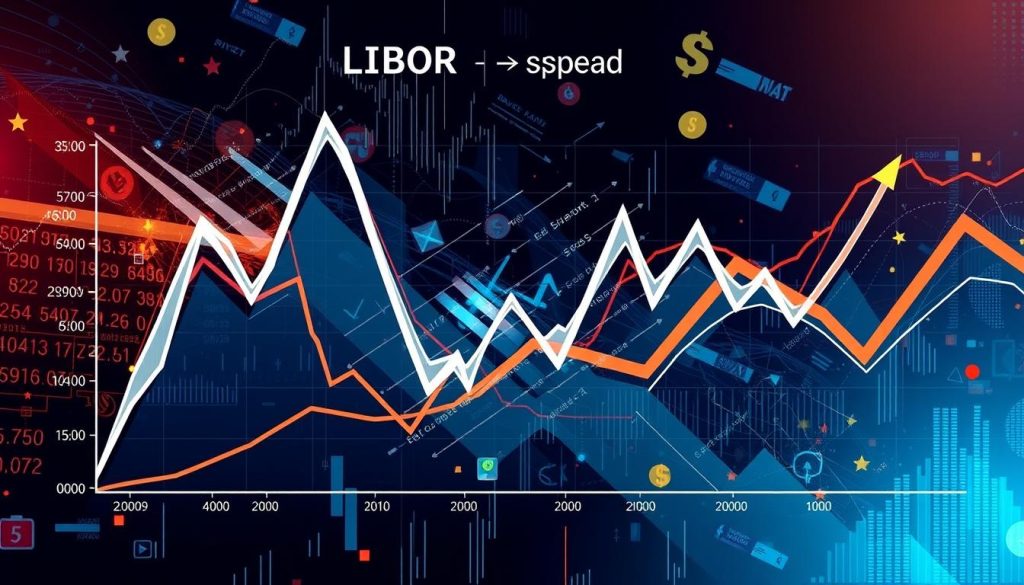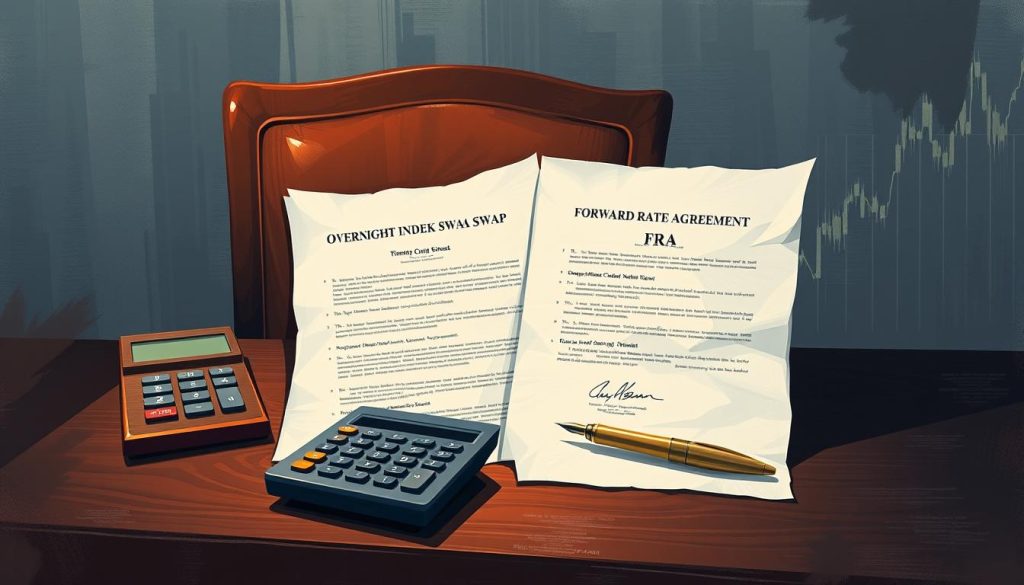If you’re a financial expert, you know how key the LIBOR-OIS spread is in the fixed-income markets. It’s a vital sign of market health, offering deep insights into bond values1, interest risks, and credit risks1. With the shift from LIBOR to overnight risk-free rates, grasping the LIBOR-OIS spread’s complexity is more crucial than ever for staying on top of the financial world’s changes.
This guide will take you deep into the LIBOR-OIS spread’s details. We’ll cover its makeup, how it’s calculated, and its effects on bond values, managing assets and liabilities, and hedging strategies. By the article’s end, you’ll fully grasp this key metric and its role in improving your decisions and managing risks.
Key Takeaways
- LIBOR-OIS spread is a key sign of market health and credit risk in the fixed-income markets
- The move from LIBOR to overnight risk-free rates, like SOFR, is changing the financial scene
- Knowing how SOFR works is vital for handling the LIBOR shift
- Using FRA-OIS spreads for hedging can help manage interest rate risks and costs
- Understanding OIS and FRA contracts is key for precise bond valuation and asset management
Transitioning from LIBOR to Overnight Risk-Free Rates
The financial world is moving from the London Interbank Offered Rate (LIBOR) to new overnight risk-free rates (RFRs)2. This big change is because of the need to make markets fairer after banks were caught manipulating LIBOR2. The new RFRs, like the Secured Overnight Financing Rate (SOFR) in the US, aim to be strong and trustworthy rates based on real market transactions2. But, they don’t capture the extra costs banks faced when funding for longer periods, which LIBOR did.
Overview of Reference Rate Reforms
Switching from LIBOR to RFRs is a big challenge for the financial world2. LIBOR was key for setting prices on many financial deals2. Changing to RFRs is like a big surgery on the financial system’s heart2. Everyone in the market will have to adjust to this new setup, which might mean using different rates for different needs.
Challenges and Implications of the LIBOR Transition
Switching to new rates has been hard and complex3. By the end of 2021, most LIBOR settings stopped, but some USD settings lasted until June 2023 for old contracts3. Many countries have made good progress in moving away from LIBOR, making interest rate benchmarks more reliable3. Yet, there’s still work to do to handle old LIBOR contracts and avoid market problems, especially in less affected areas3.
Working together on a global level is key to making the LIBOR switch faster3. Using strong reference rates brings benefits and helps avoid future problems, keeping markets stable and honest3.
| Milestone | Description | Completion Date |
|---|---|---|
| ARRC selection of SOFR | The ARRC unanimously selected SOFR as its recommended alternative to USD LIBOR | 2017 |
| Regulator guidance on LIBOR cessation | U.S. banking regulators issued guidance for supervised entities to stop new use of USD LIBOR | November 2020 |
| LIBOR cessation | The cessation of all USD LIBOR panel settings, marking the final major step in the transition | June 30, 2023 |
| SOFR as dominant U.S. dollar benchmark | SOFR is now the dominant U.S. dollar interest rate benchmark | Present |
The move from LIBOR took billions of dollars and millions of hours from the private sector2. The Paced Transition Plan had steps done on different dates, like setting up futures and OIS trading in the new rate by late 20182. Big achievements included launching CME Group’s SOFR futures in May 20182. The ARRC recommended creating a term reference rate based on SOFR derivatives in July 202123.
Understanding the Secured Overnight Financing Rate (SOFR)
SOFR stands for the Secured Overnight Financing Rate. It’s chosen by the ARRC to replace USD LIBOR4. This rate is based on real lending costs in the US Treasury repo market. The Federal Reserve Bank of New York publishes it daily, making it the broadest Treasury repo rate available4. It’s calculated by averaging transaction data from a business day4.
Characteristics and Calculation of SOFR
SOFR uses real lending transactions, unlike LIBOR which was sometimes manipulated5. Since 2019, trillions of dollars in floating-rate notes tied to SOFR have been issued in the US5. The Treasury repo market, where SOFR is based, trades over $1 trillion daily, showing real market activity5.
SOFR looks back in time, unlike LIBOR which looked forward. This changes when borrowing rates are known5. Other alternatives include SONIA, the Federal Funds Overnight Index, Ameribor, and the U.S. prime rate5. The switch from LIBOR to SOFR mainly affects financial institutions, not consumers, with changes in loan interest rates5.
| Metric | Value |
|---|---|
| SOFR Publication Start | April 20184 |
| LIBOR Phaseout Announcement | November 20204 |
| SOFR Rate on June 1, 2023 | 5.08%4 |
| June 2023 Treasury Repo Market Size | $4.8 trillion4 |
| Term SOFR Rates Published | 1-month, 3-month, 6-month, 12-month4 |
The Federal Reserve Bank of New York started publishing SOFR in April 2018, aiming to replace LIBOR4. The switch to SOFR was announced in November 2020, with LIBOR’s phaseout in June 20234. By June 1, 2023, SOFR was at 5.08%, and the Treasury repo market traded about $4.8 trillion4. The Chicago Mercantile Exchange also offers one-, three-, six-, and 12-month Term SOFR rates for derivatives markets4.

“SOFR is a more reliable and transparent reference rate than LIBOR, as it is based on actual lending transactions in the Treasury repo market rather than a panel-based survey of rates.”
Exploring the LIBOR-OIS Spread
The LIBOR-OIS spread is key to understanding credit and liquidity in the interbank market. It shows the difference between the 3-month LIBOR and the 3-month Overnight Index Swap (OIS) rates. This spread helps gauge the overall health of the market6.
Definition and Interpretation of the LIBOR-OIS Spread
The LIBOR-OIS spread shows the extra cost banks pay to borrow in the LIBOR market over the overnight market. It’s seen as a measure of bank credit quality6. Normally, the TED spread, which compares U.S. dollar LIBOR to the U.S. Treasury rate, stays under 50 basis points6.
Before, the LIBOR-OIS spread warned of market stress. It jumped from under 100 basis points to over 450 basis points in October 20086. This spike showed the high credit and liquidity risks in the market then.
Now, OIS rates help set discount rates for valuing derivatives6. The spread between OIS and LIBOR rates matters for credit risk6. OIS rates refresh more often, with a smaller credit spread than LIBOR6.
Changes in the discount curve from LIBOR to OIS affect derivatives’ value6. The switch from LIBOR to OIS discounting changes forward rates and swap values6. The impact of discount-rate versus forward-rate changes depends on the situation6.

Watching the LIBOR-OIS spread helps investors understand market sentiment and risk7. A wider spread means more credit risk and liquidity issues, while a narrower spread suggests better market conditions7. Investors might adjust their strategies based on this spread, aiming for better yields7.
Knowing how the LIBOR-OIS spread works is vital for financial experts in the interbank market. By tracking this indicator, they can better understand market conditions and make smarter choices687.,,
Hedging Strategies with FRA-OIS Spreads
As the financial world moves away from LIBOR, market players can use hedging strategies to deal with the LIBOR-OIS spread changes. One strategy is to mix a Forward Rate Agreement (FRA) trade with a forward-starting Overnight Index Swap (OIS) position. This combo lets investors bet on the 3-month LIBOR-OIS spread, which gets wider when bank credit quality drops9.
The FRA and OIS parts of this trade have the same value, with the final result based on their rate difference. By doing this, market players can protect themselves or make predictions on the LIBOR-OIS spread’s future moves9.
| Key Characteristics of FRA-OIS Spread Trades |
|---|
|
This FRA-OIS spread trade is a flexible way for market players to handle the changes in reference rates and the LIBOR-OIS spread9. By grasping and using this strategy, investors can better manage their interest rate and credit risk during the LIBOR transition10.
Overnight Index Swaps (OIS) and Forward Rate Agreements (FRAs)
In the world of finance, Overnight Index Swaps (OIS) and Forward Rate Agreements (FRAs) are getting a lot of attention. They are key in managing risks related to interest rates. They also show what the market thinks future interest rates will be.
Mechanics of OIS and FRA Contracts
An Overnight Index Swap (OIS) is a contract where the floating part is linked to an overnight rate that grows daily11. These contracts are short-term and help reduce the risk of not getting paid. Forward Rate Agreements (FRAs) are different. They use interbank rates and futures to set the price for borrowing or lending11. FRAs and short-term swaps often use IMM dates to match futures expiration.
FRAs show what the market expects future interest rates to be by being traded directly11. They are used by borrowers to fix future borrowing costs and protect against rate changes11. To calculate an FRA payment, you find the difference between the forward and floating rates. Then, multiply it by the notional amount and contract days, and divide it by the day-count convention11.
FRAs are custom-made contracts, unlike interest rate futures which are standard and traded on exchanges11. This makes futures more transparent and less risky, as they are watched more closely by regulators11.
| Instrument | Description | Key Features |
|---|---|---|
| Overnight Index Swap (OIS) | Derivative contract with floating leg tied to an overnight rate | Short-term, minimize counterparty risk |
| Forward Rate Agreement (FRA) | Derivative that uses interbank rates and futures to price notional borrowing/lending | Provide insight into market expectations, used to lock in borrowing costs |
| Interest Rate Futures | Standardized contracts traded on exchanges | Increased transparency, reduced default risk, greater regulatory oversight |
As finance changes, these derivatives are key in managing risks and showing market feelings. Knowing how OIS and FRA contracts work is vital for finance pros dealing with today’s interest rate market.

bond valuation
As the financial markets change, understanding bond valuation is key. Bond valuation is about finding the fair value of a bond. This is done by adding up the present value of its future payments and face value12.
It’s important to know about yield to maturity, present value, coupon rate, and discount rate. These factors help in valuing bonds in the new market12.
Changes in benchmark rates, like moving from LIBOR to SOFR, affect bond prices. They also change how we manage interest rate and credit risks in bond portfolios12. Investors and financial experts need to adjust their strategies to keep up with these changes12.
- The annual coupon rate of a bond is a fixed percentage of its face value12.
- The maturity date is when the issuer pays back the full face value to the bondholder12.
- A bond’s current price can be above, at, or below its par value, depending on the market12.
- The discount rate affects the bond’s price; higher rates mean lower bond prices and vice versa12.
- The bond’s price changes with the market interest rate. This affects whether it trades at a premium or discount12.
Bond valuation is key for assessing a bond’s investment quality and return rate12. It involves calculating cash flows, future interest payments, and face value to set a fair price12.
| Bond Characteristic | Description |
|---|---|
| Coupon Rate | The coupon rate is a fixed percentage of the bond’s face value, paid annually or semi-annually. For example, a $1,000 bond with a 3% annual coupon pays $30 yearly for 10 years13. |
| Interest Rate Changes | Changes in interest rates affect bond prices. Rising rates lower bond prices, while falling rates raise them13. |
| Bond Pricing | To find a bond’s fair value, investors calculate the present value of its future payments and its maturity value. This uses a discount rate to account for the time value of money13. |
| Bond Valuation Formula | The bond valuation formula discounts future cash flows to find the present fair value of the bond. This is the theoretical fair value13. |
Doing thorough research is crucial in bond valuation. It’s important to consider the risks and returns of different bonds, like junk bonds and Treasury securities13. Bonds can add diversification to a portfolio and are good for those seeking predictable income and lower risk13.
“The fair value of a bond is obtained by discounting the bond’s expected cash flows to the present using an appropriate discount rate.”14
Valuing bonds with embedded options can be tough. It requires combining option pricing with discounting14. There are different methods for bond valuation, including present value, relative price, and arbitrage-free pricing14. Stochastic calculus is used when future interest rates are uncertain, important for modeling bond options and derivatives14.
Bond valuation includes calculating clean and dirty prices. The coupon rate is the coupon payment as a percentage of the bond’s face value14. Yield to maturity (YTM) is key for pricing bonds and figuring out required returns14.
As the financial world changes, bond valuation is more important than ever. Understanding bond pricing and the effects of changing benchmark rates helps investors and financial experts make better decisions. This aligns with their investment goals and the new market12.
Impact on Asset-Liability Management
The shift from LIBOR to overnight risk-free rates changes how financial institutions manage their assets and liabilities15. Banks need a lending benchmark that matches their funding costs to handle interest rate risk15. This change might lead to “basis risk” between what they earn and what they owe15.
Managing Interest Rate Risk and Funding Costs
Financial institutions must adjust their strategies in the new rate landscape to handle the risks1516. It’s key to understand how this affects the net interest margin, which is the difference between what they pay on deposits and what they earn on loans16.
Banks and other financial institutions need to balance their assets and liabilities carefully16. They do this by matching asset and liability durations, adjusting investments, and using hedging to reduce interest rate risk1617.
| Metric | Description | Importance |
|---|---|---|
| Asset Coverage Ratio | Ratio of total assets to current liabilities and short-term debt obligations | Shows if a company can pay its short-term debts15 |
| Net Interest Margin | Difference between the interest paid on deposits and the interest earned on loans | Key for managing assets and liabilities in banking16 |
| Effective Duration | Measure of how the present value of expected cash flows changes with interest rate fluctuations | Useful for assets with changing cash flows, like mortgage-backed securities, to gauge interest rate risk17 |
By managing these key metrics, financial institutions can smoothly transition from LIBOR to overnight risk-free rates151617.
“Asset-liability management is a long-term strategy to manage risks and ensure companies can meet their obligations in the future.”15
Conclusion
The shift from LIBOR to overnight risk-free rates changes how we measure financial risks18. These new rates are strong and trustworthy, but they might miss some costs that LIBOR captured18. This could mean we see more than one type of benchmark, each serving different needs18. Experts and financial groups will have to adjust to this big change.
Understanding how to value bonds will be key in the market19. We’ll use methods like discounting and relative methods to figure out bond quality19. Tools like yield, duration, and credit spread will help us see the risks and rewards of bonds19. Strategies like diversifying and rebalancing will help make bond portfolios better19.
As finance changes, bonds will keep being crucial for making decisions for investors, issuers, and regulators19. Adjusting to the LIBOR-OIS change and seeing the new opportunities will be vital for a strong financial system.
FAQ
What is the LIBOR-OIS spread and how is it defined?
The LIBOR-OIS spread is the difference between the 3-month LIBOR rate and the 3-month Overnight Index Swap (OIS) rate. It shows the premium for borrowing in the LIBOR market over the overnight market. This spread reflects credit and liquidity conditions in the interbank market.
What is the Secured Overnight Financing Rate (SOFR) and how is it calculated?
SOFR is the overnight risk-free rate chosen by the Alternative Reference Rates Committee (ARRC) to replace USD LIBOR. It’s based on the US Treasury repo market and shows the cost of overnight borrowing and lending. The Federal Reserve Bank of New York publishes SOFR daily, using a volume-weighted median of transaction data from the business day.
How can market participants hedge against or express a view on the LIBOR-OIS spread?
To hedge against or take a view on the LIBOR-OIS spread, market participants use FRA and OIS trades. This strategy allows investors to bet on the spread’s future movements. The spread widens when bank credit quality worsens.
How do Overnight Index Swaps (OIS) and Forward Rate Agreements (FRAs) work?
OIS are derivatives with a floating leg tied to an overnight rate, compounded daily. They are short-term and reduce counterparty risk. FRAs, on the other hand, are derivatives that combine interbank rates and futures to price borrowing or lending. Both use IMM dates to match futures expiries.
How does the transition from LIBOR to overnight risk-free rates impact bond valuation?
The shift from LIBOR to overnight risk-free rates changes how bonds are valued. Factors like yield to maturity, present value, and discount rate matter more now. This change affects bond prices and how to manage interest and credit risks in bond portfolios.
What are the implications of the LIBOR transition for asset-liability management?
The LIBOR transition affects how financial institutions manage their assets and liabilities. Banks need a benchmark that matches their funding costs to manage interest rate risk. The gap between new RFRs and funding costs can lead to “basis risk” between assets and liabilities, requiring careful management.

